On Chicago's far northwest side, neon arrows flicker with desperation. The marquees they ornament compete fiercely for recognition. The Apache promises "Color TV by RCA," while the Patio cries out in glowing script: "An Adventure in Living!" Adventure I was prepared for. I had loaded down my boyfriend's bicycle with two sleeping bags, two oranges and my travel Scrabble game.
Sidney H. Morris, who designed the once lavish Villa Moderne motor hotel in Northbrook, envisioned the future of the American motel decades ago. "Reservations will be made by radio transmitter in the moving car," he told the Tribune in 1960, "and guests will get a look at their accommodations in advance by television." Nearly 50 years later, I was scouring the strip by bicycle, searching for the motel that looked least run-down, ultimately choosing the Lincoln Inn for its gray and pink exterior, its modernistic angled windows and its promise of "clean, quiet, comfortable" rooms, advertised on a banner outside.
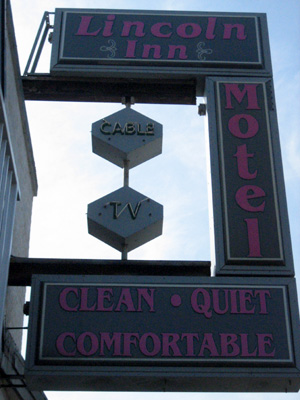
"How long you want it for?" asked the man behind the glass in the mirrored first-floor office. There was a printed sheet of paper taped to the window: "This is a prostitution-free zone."
"Overnight," I said to my boyfriend, John, who I had elected to communicate for me.
"Overnight," he relayed through the opening in the window. The room cost $45, plus $2 key deposit. Then I noticed another sign in the window, informing that a 10-hour stay cost only $35.
"Let's do that," I said, mindful of my wallet and doubtful we'd want to stay much longer.
We presented our IDs, and John signed the registration card. He checked the box on line one, certifying that he would hereby not engage in any illegal activities while in the room, including prostitution, solicitation, and gambling.
Motel Row, the two-mile stretch of Lincoln Avenue home to ten working motels from the 1950s, has long been associated with crime. The opportunity for illicit activity is practically inherent in each motel's design, arrangements in which guests check in through a pane of glass and share neither a corridor nor elevator with other lodgers.
Whether or not motel architects were aware of this inborn potential for scandal, motels rose quickly in the '50s and early '60s, catering to a post-war motoring public hungry for a new and modern travel experience. On North Lincoln Avenue, the street itself is the first indication of the motor hotel's glory days. At Foster, where Motel Row begins, Lincoln Avenue gets wide, taking on additional lanes. Traffic cruises by at an increased rate of speed, piping out white exhaust into the icy air. The bike lane disappears, and suddenly I feel uneasy. Unlike the crowded, narrow, city streets I know, this is a strip made for motorists. This is U.S. Route 41.
Before the opening of the Edens Expressway — Chicago's first "superhighway" — in 1951, Route 41 was Chicago's main inroad. Glimmering as Lake Shore Drive, Route 41 hugs the calm Lake Michigan water, passing sailboats and joggers in the summer, revealing a new picture of the city with every well-planned, graceful curve. "It's easy to be proud of Chicago," Tribune correspondent Hal Foust wrote in 1952, "if you stick to the lakefront."
In the early '50s, a special motorcade cruised the entirety of Route 41, traveling from Naples, Florida to the highway's northern terminus in Copper Harbor, Michigan, on the tip of the Upper Peninsula. Where Lake Shore ended, they jogged left, then chugged north past the site of Motel Row in a cloud of gas fumes. "This is the historic method of promoting recreational traffic for a highway," the Chicago Tribune reported. The event was historic in a recent sense only — recreational motoring had just emerged as a popular, affordable way to travel in the post-war years.
"Motoring travelers considered themselves modern travelers," says City of Chicago cultural historian Tim Samuelson. They didn't mind that their lodgings would be found on the city's edge — that location meant cheap rates and more room to park cars. According to one South Side motel manager, quoted in the Tribune in 1960, a motel, by definition, must provide a traveler "the opportunity to park his car adjacent to his living accommodations." At rest in concrete courtyards, cars spent the night only steps away from the doors to their owners' rooms. By morning, the recreational motorist would be ready to jump back into his tail-finned Cadillac or salmon-colored Chevrolet and hit the next town.
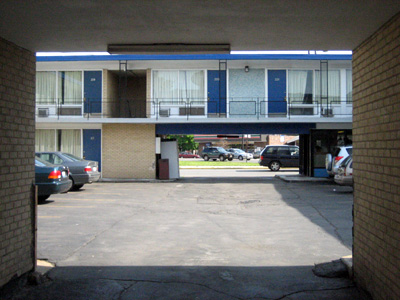
If you're a motorist on the move, why pay to be near the action downtown when motels offered cocktail lounges, swimming pools and other luxuries on site? "Today's motels share only a common name with the highway lodgings of yesteryear," an optimistic Tribune reporter wrote in 1960. "Today they come in all shapes and sizes, each one designed to lure Mr. Motorist from behind the wheel." Together, color televisions, switchboards, kitchenettes and ice cube machines created a vision of modern living middle-class families could experience firsthand.
"It was kind of a dream," says Samuelson, who remembers traveling to motels as a boy in the 1950s. "You could have what you wished had at home."
And if these features didn't get you to hit the brakes, the twinkling marquees, daring cantilevers, and bright colors would. If you look hard, traces of this vibrancy are still detectable on Motel Row — in the glass tiles of the Apache, for example, or the garish aqua and orange color scheme of the Patio. The war had brought with it advances in construction and new materials — reinforced concrete, plastic and neon — which architects incorporated into bold, over-the-top designs. Samuelson calls it "look-at-me" architecture.
"Architecture became like show business," he says of '50s-era motels. He remembers staying at one motel that was fashioned as giant Thunderbird, with the bird's proud head at the center and two rows of rooms fanning outward, representing mighty wings. A 1960 article praised such lodgings as "modernistic palaces" and "highway castles."
By the late '50s and early '60s, Chicago's motel industry was booming. In 1953, zoning laws first began allowing motels within the city limits. By 1960, motel construction would be the second-most widespread form of commercial construction in the metropolitan area. That year, Chicagoland was already home to over 150 motels, with dozens more on their way up.
The city itself was booming too, attracting more visitors than ever before. McCormick Place had opened in 1960, made Chicago a top convention destination, and O'Hare Airport, which had only begun commercial service in 1955, was quickly on its way to becoming the world's busiest airport (a title it would earn by 1962). With the establishment of the Interstate Highway System in 1956, federal dollars sparked the development of new expressways, such as the Kennedy, which opened in 1960. "With good highways, more people drive," a commercial development director told the Tribune that year, "and motels naturally attract motorists."
Few critics cautioned against overbuilding during the motel boom of the early '60s. But one hotel association official predicted that Chicago's motels would, like Miami Beach's, one day be unable to fill their rows of empty rooms. Motel rates would continue to drop, he argued, while hotel rates would remain relatively constant. "It could happen here within a few years," William J. Wilson warned readers in 1960.

As I inserted the key and opened the brown metal door to Room 15, I could feel the overwhelming heat of the small, stuffy room. Entering, I felt myself pass through a wall of steamy air, heavily scented with the strong smell of cleaning products. In this chemical and climatic bubble, a mirror on the ceiling stretched over the bed, and two streaky handprints reached up from above the headboard.
We took our bikes from the patio, and wheeled them inside for paranoid safekeeping. It occurred to me that I too, like other modern-day patrons I had considered, was not about to use a motel room in the way it was originally intended. (If the birth of the motel was wrapped up in the preeminence of the automobile, what was I doing here on a bicycle?) I was not a weary traveler, out-of-towner, or motorist. I was a just a local who wanted to know if the Tribune's 1960 proclamation "Neon Promises Tempt Traveler with Luxuries," still meant anything on Motel Row.
"Bathrooms will contain therapy tubs for the weary traveler," Morris had predicted in the article. Surely he did not envision the ringed porcelain pit in our bathroom, where the doorknob dangled loose in its socket. A fist-sized hole was punched into the inside of the bathroom door, as if someone locked inside had tried desperately to escape.
"Furniture will include a vibrator chair or couch," Morris foretold, "and while the guest sleeps, ultrasonic devices built into the closet will dry-clean his clothes for a fresh start in the morning." The dresser drawers were coated with ashes, gunk and autographs done in Sharpie — a three-point pitchfork and a broken dagger, a heart, "Jenn loves Joey 4-Ever." Even the large, boxy television bore a special inscription burned into its side — "Stolen from Admiral Motel." Each object, each marking, each handprint seemed to leave its own story to my imagination, none of which offered much comfort. There were too many stories in this room, I sensed, and no trace of the futuristic luxuries Morris had promised.
Though I was prepared for this outcome, I still felt disappointed that our room was so completely devoid of charm or kitsch. When I had first seen Motel Row, the preservationist in me wanted to save the whole square mile in a giant time capsule — in the city or outside of it, I had never before seen a bigger slice of 1950s Americana. In the fading signs for coffee shops and color TVs, I caught a Technicolor glimpse of a bustling, glittering past.
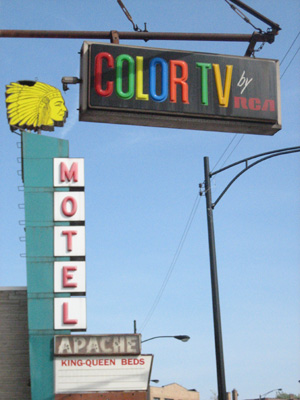
I unrolled my sleeping bag and watched some television with John, flipping between a program on the city council election and a cable-access show about Frankie Knuckles. The house music was tiring and repetitive, the responses of the aldermanic hopefuls swift and polished.
When the television and the lights went out for the night, my heart was beating strongly. I lay awake, expecting to hear a strange noise, a pounding on the metal door, or a rattling of the cheap lock. I heard nothing. When the alarm on my phone rang the next morning, I didn't hesitate before I jumped out of bed, ran water to brush my teeth, and zipped up my backpack to leave.
That night in Room 15, I thought about what had stopped Morris's vision from being realized. "If it is built for and caters to the convenience and informality of motor travel, it is a motel," a motel magazine exec told the Tribune in 1960. Yet increased motor travel was to play a great role in Motel Row's demise. While Chicago's new superhighway system brought more traffic volume through Chicago, it allowed for faster travel. People could reach final destinations more quickly — eliminating the need for a North Side stopover. (And the most modern of modern travelers weren't stopping anywhere — they were traveling by air.) As the Edens and Kennedy emerged as Chicago's dominant inroads, Lincoln Avenue became an unnecessary detour. High-speed travelers could pull right off the expressway and into a budget chain, such as Holiday Inn. Chains kept cost low, but maintained a high degree of quality and service. "You could count on a nice experience," Samuelson says, although, he adds, he often prefers adventure and surprise over this guarantee.
Samuelson says that by 1965 Motel Row was entering "a period of aesthetic limbo." "It's a speeding railroad train that every building hits," he says. No building can stop this hurdle from coming, he says. Some structures can overcome it. Others cannot. The '50s had marked a period of dramatic, futuristic design. But fashions in architecture — like fashions on the street — change. With the new colors and forms of the '60s, existing motels became "too old to be new and too new to be old."
Already too outmoded to offer travelers a modern living experience and suffering from decreased traffic, motel owners struggled to profit. Upkeep suffered while rates remained low. Privacy came cheap, and with it, the opportunity to do what one pleased.
"Once you got your key, you had your own place," Samuelson says. "You could be very anonymous." This, he adds, was the undoing of the motel's reputation.
Thousands of dramas played out behind Chicago's closed motel-room doors. Samuelson remembers passing the Seville Motel on Stony Island Avenue on his way to work one morning and seeing a large, burly man — stark naked — on the second-floor patio. A woman wearing nothing but a towel was running away barefoot, hurrying down the outdoor steps.
"He said, 'Come back baby,'" Samuelson recalls, laughing. "'Come back.'"
Other activities, however, were far less benign. By the 1980s, major crimes called attention to Motel Row. In 1981 — the year in which over $2 million in cocaine was recovered from the Spa Motel — a suburban factory worker used various Lincoln Avenue motel rooms to commit a series of rapes and robberies. Timothy Mabe planned each assault carefully, selecting his victims in advance and choosing motels with convenient, secluded escape routes. Fleeing down dark alleyways to avoid police, Mabe carried out a four-month string of attacks. He began at the Diplomat, the motel furthest south on the strip, and continued north to the Spa, the Apache, the Villa and the Patio. All but the Villa remain standing on the strip today. Police described the 23-year-old Mabe, who carried a handgun, knife and handcuffs, as "polite," and often apologetic. (After his 2005 release from prison, he was sent back to jail for life on new sexual assault charges.)
While some motel rooms were used for illegal activity, others were used for honest purposes. A motel room could even serve as housing. The husband of one of the Motel Row attack victims told the Tribune that his family had actually settled in the motel as a temporary measure. They were looking for permanent housing that would take the family's four children.
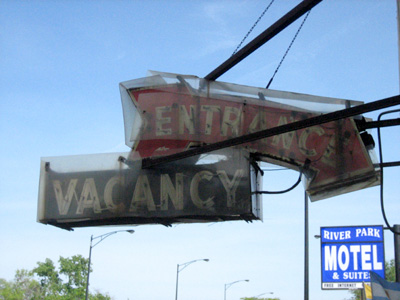
I had read about other long-term guests, and several clerks on Motel Row confirmed that this was common practice. Dave Patel, a manager at the Patio, said that his motel housed a woman who had previously lived in the Stars. When that motel was demolished in August of 2006, the owner wanted to make sure the woman had a place to go — so he called the Patio. At the O-Mi, clerk Sunney Pendey told me that one guest in his 70s has lived at the motel for more than eight years. Data from the 2000 census reported 177 people living in motel and YMCA rooms in the Motel Row area.
Crain's profiled one of the Apache's long-term guests last year — a man who described himself as a Catholic priest and monk. For $285 a week, the man shared a room with another self-proclaimed monk. I understood that a motel room could be a home, but even the cheapest motel wasn't exactly cost effective. The men at the Apache were paying $1140 a month — easily the cost of an apartment in Chicago. Perhaps then, the lack of something else — credit, references or identification — was keeping them from legitimately renting more permanent housing.
At any rate, the price got the pair a mini-fridge and a coffee pot, allowing them to live, for the most part, off sandwiches and cereal. In addition to a clean bathroom and fresh linens, the man said the Apache also offered him a place to say Mass beside his bed. He said he felt a sense of community, perhaps because for the first time in a long while, someone was looking after him.
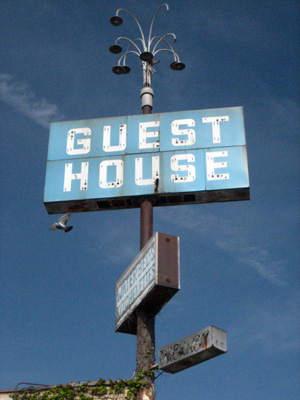
Apart from the limited business of these long-term residents, I wanted to know how Motel Row was still making a go of it. At first glance, it appeared that business wasn't exactly booming. At the Summit (another tragic exaggeration — the motel sits atop a barely detectable rise), a rusty shopping cart saddled with dingy rags and spray bottles serves as a makeshift cleaning trolley, waiting outside a room. It seems there aren't that many rooms to clean today. The spacious parking lot is nearly devoid of cars.
In the wood-paneled office, the day moves slowly for the clerk behind the glass. If she needs to, she will interact with customers using the flexible microphone that extends from her window. Dismal gumballs rest in yellowing dispenser tanks near the counter. If business is always this slow, I would guess no one has put a quarter in their slots for years.
I circle the parking lot on my bicycle, looking for the "coffee shop and lounge" the neon sign promised. For an instant, I lock eyes with the dark-haired woman in the office, though I know from the monitors behind her that she was already watching me.
Pendey, the clerk at the O-Mi, says that winter is a slow time on Motel Row, especially during the week. Other clerks I spoke to agreed. During the summer, however, weeknight occupancy rises to about 60 percent. Year round, the motels are almost always full on weekends.
As far as criminal activity goes, the worst Pendey's had to deal with are the occasional "youngsters" who throw parties. (All guests are over 21, he reminds me.) "They are smart," Pendey says, of the party-goers who have removed smoke detectors. "Very smart."
While I was talking to Pendey through the glass, a slim man in a sweatshirt burst into the lobby, out of breath. "You got room 24 for me?" he asked, a quiet male friend in tow. The man was holding a colorful Nerf-style bow and arrow.
Pendey said he didn't have anything ready.
"I'm in 21 already," the man explained, irritated, and after a moment, Pendey produced a key.
"A different guy every week," Pendey told me once the pair had left. The man comes in regularly, never checking in with his own ID, but always the ID of his guest.
I saw very different group of people approach the O-Mi later that day. A mother, father, and child chewing on a sucker were dressed in their warmest winter coats. Together they fussed with a stroller, another child, and full bags of groceries from Dominick's.
"It's me, my husband, and two kids," the woman told Pendey. He told her it would take an hour to have a room cleaned. Frustrated, she rejoined her family outside in the cold, and I watched them walk away.
At the Rio Motel that day, Emile Apelike, a recent immigrant from Togo, was working a double shift. He had a police report on the desk in front of him. He told me that the night before, a couple in one of his rooms had caused a disturbance.
"They fight with bottles, you know what I mean?" he said, indicating his forearms. His expressive long eyebrows pressed together in frustration. Apelike told me both had gone to jail last night on criminal damage counts. The whole room, he said, had been destroyed. "Fighting all night," Apelike said, "Broke bottles, blood on the carpet." The room was still in disarray — cleanup was going to require new linens, new windows, and a new door.
Apelike said that last night's incident was only the second he'd seen since he began work in August. He told me, quite candidly, about a taxi driver who, after having sex with a prostitute, decided to take a bath. When he came out of the bathroom, the woman had taken his keys and stolen his cab.
Other clerks on the strip were far less affable. Like Apelike, many were recent immigrants. ("I'm a new person in this country," one told me, unable to answer my question about occupancy.) Others simply said they did not wish to talk with me ("We don't do that sort of thing here"). In every case, motel owners were unavailable. Some, I learned, rarely visited their properties.
At the Lincoln Motel, a South Asian man was chewing on sticky brown seeds behind the glass. I arrived just as he was finishing a phone conversation.
"You know it's not good for you," I heard him say. I watched him chuckle to himself, and I could see the seeds stuck between his teeth as he grinned. "You want more time?" he continued. "I give you one hour."
I could only guess what he might have been talking about. When I asked him if he'd like to chat, his smile disappeared.
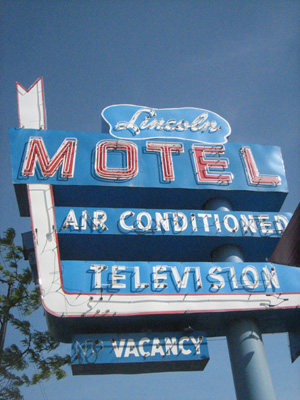
I closed the door to Room 15, and I stepped out onto the concrete porch, into the cold light of Lincoln Avenue at dawn. The temperature hovered in the teens, and an ugly sort of sunrise struggled for visibility through the thick gray clouds. Looking down at the slushy street from the balcony, unsure if I had slept more than a few moments, I felt as if I had awoken from a strange, unfulfilling dream.
We returned our key to the office to collect our $2 deposit. Behind the glass, a new clerk was working the early-morning shift. He wore a neat mustache, gold-framed glasses and a plaid shirt. I asked John to ask the man if we could have a copy of our registration card, which I wanted as a souvenir.
"Is there an extra copy of the registration card that we could have?" John asked politely.
"No," the man said curtly, without really looking at us. "The card stays here."
"Could we get a photocopy of one, or anything?"
"No," he said, looking up and moving toward the window, his accent becoming stronger. "We don't have a photocopier."
"Oh, OK," John said as we continued stand in the lobby.
"No," the man repeated, throwing his hands in the air. "Nobody gets this card."
"OK," John said as we moved to the door.
"No," the man said again. He was now angry. "Nobody can have a copy of this card — not even the police!"
Over the past eight years, a gradual transformation has been taking place on Lincoln Avenue. Motels have been falling, one by one. Between 1999 and 2003, the city used eminent domain to acquire three motels — the Spa, Acres and Riverside — and transform them into public use projects (a police station, library and park, respectively). Most recently, in August of 2006, private developers purchased the Stars Motel for $2-3 million. In front of the Stars' old sign advertising a switchboard and free television, a new sign promotes the coming of Village Center, a five-story luxury condo and retail building. (The sign was at one time up for grabs on eBay.)
"People were pleased to see the wrecking ball hit," says Timothy Czarnecki, a long-time staffer of 40th Ward alderman Patrick O'Connor. Czarnecki, along with Mayor Daley and a slew of local media, was present for the Riverside demolition.
"They served a purpose once," he says of the motels, "but they changed from motels to halfway houses and venues for prostitution."
"People have been upset for a number of years," he adds.
Since his initial push for public-use projects, Alderman O'Connor has sought out proposals from private developers. According to Czarnecki, approximately half a million dollars in TIF funding is available as an incentive to developers. The funds cover certain project costs, such as demolition.
"A canyon of condominiums," Czarnecki says, has helped revitalize the neighborhood and local businesses. Wherever Lincoln Avenue lacks motels, it is peppered with mostly Korean establishments — stationary shops, furniture stores and the Korean branch of the YMCA — which have spilled over from "Koreatown" in nearby Albany Park. Many stores, which have struggled with rising property taxes, are choosing to add condos above street level to generate extra revenue. Czarnecki is hopeful that the condos will bring about more pedestrian traffic on Lincoln Avenue.
The public has clearly benefited from the Lincoln Avenue redevelopment in many ways. On any given day, joggers and dog-walkers move briskly through Legion Park and families emerge from the Budlong Woods Library, a week's worth of books in their arms. According to Crain's, motel demolitions have also helped reduce crime. The magazine reported a 49 percent reduction in crime since the first thee motels were razed.
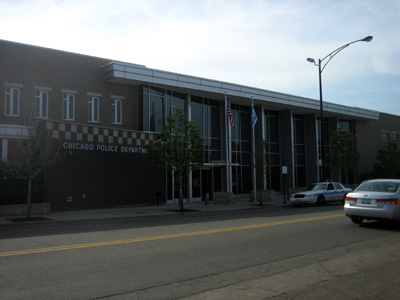
At the 20th District station house, the site of the former Spa Motel, Officer Cesar Garcia tells me that motels are no longer major hotbeds of crime. In fact, he reminds me, the 20th District has the lowest crime rate in the entire city. Prostitution, Garcia says, is no longer an issue on street corners, although it does remain a problem. He asks me if I've ever heard of the Chicago Reader. The ads on the back page, he says, are a gateway through which prostitution is still arranged and carried out, in a much less visible way, on Motel Row.
The Spa, where the gray concrete station house now stands, was a frequent crash pad for traveling rock musicians, including Anthrax and the Ramones. According to an old picture postcard, guests here once enjoyed "luxuriously furnished rooms, ample parking, free ice, color TV, and AM-FM radios." The reverse side of the card displays a cocktail lounge with red upholstered swivel chairs and a bedroom decorated in olive green and harvest gold. As I exit the station, I wonder if I'm passing through the cocktail lounge that moment.
At the Chicago Historical Society, I study a picture of the Summit Motel, photographed on a sunny day in 1962. Signs outside the lounge advertise "Twist Night" every Wednesday: "Free Lessons." A tilted martini glass and Schlitz sign dance beside music notes painted on the windows. I see the coffee shop I was never able to find. "Have a Pepsi" its sign says. Sitting in the research center wearing white gloves, I wish desperately that I could go back in time. Just for one twist lesson.
I ask Samuelson if there's any possibility one of the Lincoln Avenue motels could be restored to its original charm.
"If I had lots of money, I'd sure like to try to make a go of it," Samuelson says of a motel restoration project.
The historian was once interested in the transforming the Snowflake Motel in St. Joseph, Michigan, into a camp for architecture students. Rooms arranged in a star shape radiated from a central office, and bright red beams crisscrossed to create geometric forms. Frank Lloyd Wright's son-in-law had designed the 1962 building and even the furniture in it. The Snowflake was razed in 2006.
Samuelson, who lives in a 1949 high-rise by Mies Van der Rohe, likes to keep things original. He prefers his Formica worn out, he says, and he speaks mostly from a rotary telephone.
"People who had lived there thought I was from the moon," Samuelson says of his neighbors. "People there wanted new things."
With new developments springing up on Lincoln Avenue, I wondered if a twist lesson at the Summit would be a little less charming if it was flanked by redbrick condos. Even with perfect restoration, a certain context would be lost, I thought, and I was after the whole picture.
I ask Samuelson if he thinks people would like to see a Lincoln Avenue motel restored to its former glory. Maybe, he says.
"But it wouldn't be the same without driving up in a '58 Mercury with the top down."





